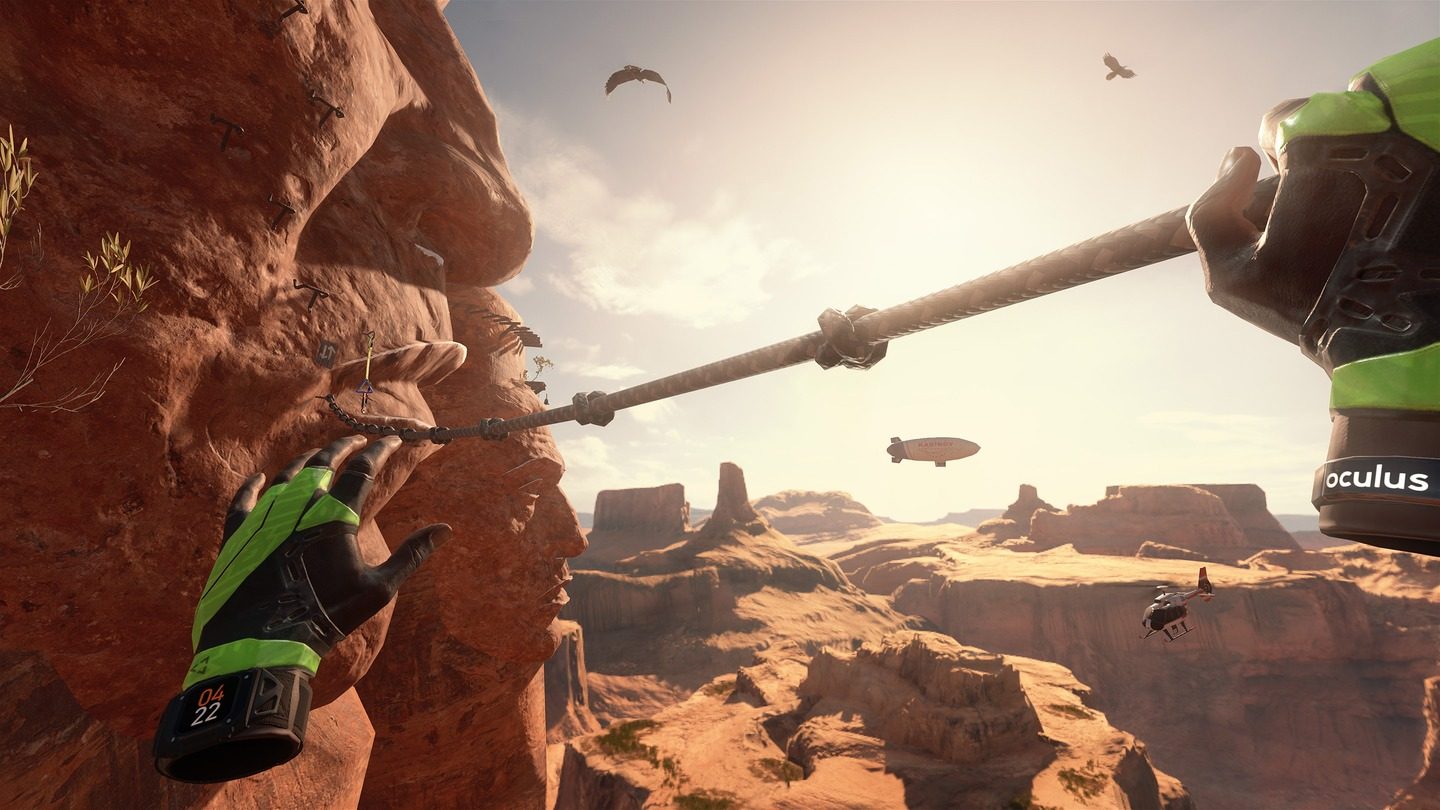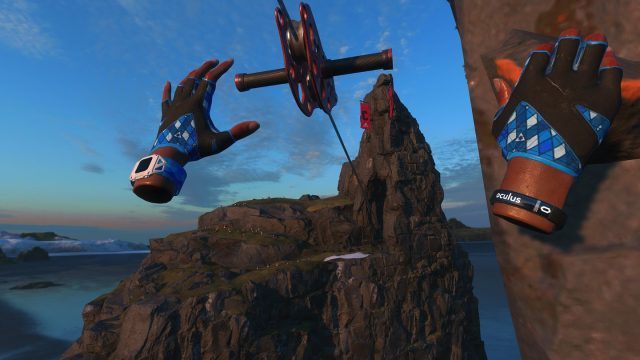The Climb 2 has continued to refine what made the first game in the franchise so much fun. It serves up more interesting and challenging climbs across more exotic locales, and it does it with a few new flourishes over the original that will have you revisiting levels and leaving little to dislike about Crytek’s acrophobia-inducing sequel.
The Climb 2 Details:
Available On: Oculus Quest
Release Date: March 4th, 2021
Price: $30
Developer: Crytek
Reviewed On: Quest 2
Gameplay
Here’s some ancient history: I first played The Climb after it launched on Oculus Rift in 2016; it was a technically impressive game but suffered from the lack of motion controls, which really hampered the whole experience. That was before Oculus released Touch to consumers, and they were still bundling original Rifts with an Xbox One controller. It’s amazing to see how far we’ve come with standalone VR headsets in the meantime, and as a result The Climb 2 feels miles away from my first experience with its predecessor.
Of course, I’ve since played The Climb the way it was meant to be experienced, namely with full motion controls so you can physically stretch and grab your way through the winding handholds through each level, and wirelessly so you can really go wild. And The Climb 2 follows very much the same recipe as the first, although there are a few notable differences between the two that make the sequel a more enjoyable experience overall.

On the outside, The Climb 2 may feel very similar, however it actually offers a more diverse collection of climbing possibilities that go beyond the original. That’s not to say I wish it didn’t go conceptually farther in some areas, but it’s a worthy successor just the same.
Level design shines in The Climb 2, giving you a host of options to amble up each of the game’s separate mountain formations. Harder and easier routes present themselves along the way, so you can climb however you feel most comfortable. Far jumps with crumbling handholds make for great shortcuts, but also pretty obvious deathtraps. You can choose to venture through even more annoying handholds, like the ones you have to dust off first, or the ones with spikes that sap your virtual stamina. Things like unsafe ladders and loose monkey bars are everywhere, so you have to choose wisely.
It’s easy to throw caution to the wind though since the periodic checkpoint system allows for automatic restarts. Like in the original, you also have two supernatural gifts too (outside of incredible arm strength) that I never really used. You can rewind to your last checkpoint once per climb if you need to backtrack, and you can magically reveal available pathways if you’re lost. I tended to look around first for obvious pathways, so I never really ended up using either.
The number of levels are the same as the first—15 in both—but there’s a greater diversification of areas to climb around in the new game. In The Climb 2, you return to the first three areas (Alps, Bay, Canyon), which feel very much like rejiggered versions from the first game, but then you’re offered two entirely new areas: City, a very Mirror’s Edge-looking assortment of contemporary buildings and skyscrapers, and North, basically rural Iceland, replete with polar bears and puffins.
My favorite by far was the City area, which offered a bunch of unique gadgets and one-off climbing experiences. Shimmying from exposed brick to a crane ladder, and then to a zipline through the building tops is simply a thrilling experience.
On the other side, I find construction scaffolding that makes you slip down a level if you’re not careful which pipe you grip. My only wish is Crytek spent more time building unique cityscapes, since they offered such a fun and weird mix of climbing possibilities. Basically, I’d play the hell out of a hypothetical The Climb: City Edition.
One of the most puzzling gadgets is the many flipping billboard walls that offer temporary handholds, making it a timed exercise. I would do everything I could to launch myself past these if I could.
All areas offer three distinct difficulty levels, each of which took me around 15 minutes to complete on the first run, making for a little under four hours of gameplay. That’s with only playing each level once, and not challenging other users on the leaderboard, which superimposes a ghostly pair of hands into your run up the cliff.
One minor thing that’s worth mentioning is that chalking has changed for the better. Although you still need to depress the secondary trigger and shake your hands for chalk, it feels about 50 percent faster, which makes the process less annoying. Just like the game’s predecessor, you don’t really need chalk if you can manage the ‘just right’ grip strategy, but it’s nice to know that it’s a slightly less cumbersome action.
Lastly, my least favorite discussion is about leaderboards. I think the game is engaging enough not to even need to focus on leaderboards, although some may differ in that opinion. Just the same, you can accrue points by comboing grips, which is done my moving fast enough to not break the combo chain. The faster your run, the higher your score. The more challenging grips, the higher the score. If you’re into obsessing over points, The Climb 2 will accommodate.
Immersion
The Climb 2 can be breathtakingly beautiful. That said, at least in my prerelease version, it feels like the game is knocking up against Quest 2’s modest compute overhead, which necessitates some lower res textures, and also what I assume is a very strong use of FFR (fixed foveated rendering), as you can clearly see the border between higher resolution sections in the middle of your field of view and those ‘feathered out’ in the periphery.
That may just be that the game needs more optimizing, because even with these minor niggles in mind, it’s ultimately well executed when it comes to not only the static visuals, but also its moving parts, like the world’s wildlife.
It’s pretty often that you’ll look over your shoulder and see a curious little beast curiously peering down at you, making you feel a little less alone in the whole pursuit. Some aren’t so friendly though.
You’ll also run into physics-based things like dangling bags, ropes, and climber tents that you can use as grips, which makes the world feel more alive. The Climb 2 also does a much better job of integrating hand grips into the climbing environment, so they aren’t nearly as glaring as the stark white lines from the original.
Comfort
Climbing in VR is a surprisingly immersive way of moving around, but also really comfortable. There’s something about artificially shifting your point of view with a direct 1:1 hand movement that keeps you feeling in control. I played for hours at a time, and I never felt wobbly or nauseous.
Here’s some advice from a VR old timer: make sure to keep an eye on your neck.
The Climb 2 is best played standing up or in a chair that can recline somewhat. It’s not because you’ll need your full body to play, because you really only need enough space in front of you to swing your arms. Rather, having regularly played VR games for the past six years, I can say with confidence that the strain your VR headset can put on your neck isn’t inconsequential. Inclining your head using only your neck as the fulcrum at a 90-degree angle and not compensating with your body’s physical posture (standing or sitting) is a recipe for strains and stiffness, which can linger well after you’re done playing.
Overall Score: 8.5 – Great
WE SCORE ON A LINEAR SCALE – Learn More
From the outside looking it, The Climb 2 feels very much like the first, with its gamified freeclimbing and leaderboard-centric gameplay. But just under the surface is a newer, bolder game that goes in a few unexpected directions. New environments host fun gadgets like ziplines and moving platforms, and plenty of choice when it comes to self-imposed difficulty. Level design is spot on, although visuals could be better optimized for a more immersive experience.
Gameplay: 9 | Immersion: 7.5 | Comfort: 8.5



